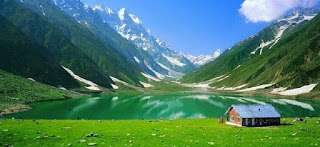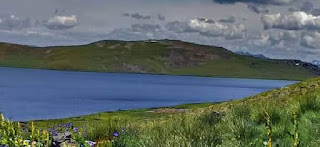Deosai (The Shadow of Giants)
 |
| View of Deosai National Park (Image courtesy Facebook) |
Deosai National park is located at the junction of Skardu District and Astor District of Gilgit-Baltistan.
It is also known as Little Tibet. It is covered with snow for eight months of the year, but from May to August, this place turns into a green valley.
The park’s unique high-altitude ecosystem, diverse wildlife, and beautiful landscapes make it an ideal destination for nature lovers, hikers, and adventure seekers. Deosai is one of the largest and most beautiful plateaus in the world.
Meaning of Deosai
Deosai is a combination of two Balti words "Dev" and "Sai". Dev means giant and Sai means shadow. Its means "the shadow of giants". The local people believe that this place is still the abode of supernatural beings because the weather changes here are very unpredictable. Sometimes it starts snowing in summer, sometimes it starts raining suddenly.
History of Deosai
Deosai National Park has a rich and fascinating history that stretches back thousands of years.
The park’s earliest known inhabitants were the Dards, an ancient people who lived in the region for thousands of years. The Dards were nomadic herders who moved through the region with their flocks of sheep and goats, taking advantage of the park’s seasonal grasslands and alpine meadows. They left behind rock carvings and other artifacts that can still be seen in the park today.
Later, the region was ruled by the Buddhist kingdoms of Gandhara and Baltistan, and later it was ruled by the Muslim king of Skardu. In the 19th century, the region was explored by European explorers and mountaineers, who were drawn to the park’s rugged terrain and high peaks. The park was officially established as a protected area in 1993, to preserve the park’s unique ecosystem and cultural heritage.
Geographical Location of Deosai
Deosai National Park is situated in the northern region of Pakistan, in the Karakoram mountain range. The park covers an area of around 3,000 square kilometers and is known for its high altitude of around 4,114 meters above sea level. The park is located in the Skardu district of Gilgit-Baltistan, and it stretches from the Indus River in the west to the Shyok River in the east.
The park’s high altitude and unique geography make it an ideal destination for nature lovers and adventure seekers. The park’s landscapes are diverse and include alpine meadows, rocky mountains, and glaciers. The park’s high altitude also makes it an ideal place for trekking and hiking. Visitors can explore the park’s beautiful landscapes on foot and take in the breathtaking views of the surrounding mountains.
The climate of Deosai
The park’s climate is characterized by its high altitude and cold temperatures. The park’s weather is generally cool and dry, with temperatures ranging between -10°C to 15°C. The park’s temperature is also affected by its altitude, with temperatures dropping as visitors ascend to higher elevations. The park’s summer months, from June to September, are the best time to visit, as the weather is mild and the park’s high-altitude lake, Deosai Lake, is accessible.
The park’s winter months, from October to May, are characterized by heavy snowfall, and the park’s high-altitude lake, Deosai Lake, is inaccessible. The park’s winter months are not considered the best time to visit, as the weather is harsh, and access to the park is limited.
Wildlife in Deosai
 |
| Bear in Deosai National Park (Image courtesy Facebook) |
Deosai National Park is home to a diverse array of wildlife, making it an ideal destination for wildlife watching and photography.
The Himalayan ibex is one of the most iconic animals found in Deosai National Park.
The snow leopard is another iconic animal found in Deosai National Park.
It is also the home of other animals such as the Markhor, Urial, Brown Bear, and Gray Wolf. The park’s unique high-altitude ecosystem is also home to a wide variety of bird species, including the Himalayan monal, the golden eagle, and the griffon vulture.
Plant life in Deosai
 |
| Deosai (Image by Facebook) |
Deosai National Park is home to a diverse array of plant life, making it an ideal destination for botanists and nature enthusiasts. The park’s unique high-altitude ecosystem is home to a wide variety of plant species, including the Himalayan blue poppy, Himalayan wild rose, and Himalayan cedar.
The park is also home to a wide variety of other plant species, including the Himalayan primrose, Himalayan bellflower, Himalayan Himalayan wild strawberry, and Himalayan white poppy. It is also home to a wide variety of medicinal plants which are being used by locals to cure many diseases.
Outdoor activities in Deosai
Deosai National Park offers a wide variety of outdoor activities for visitors to enjoy, making it an ideal destination for adventure seekers and nature enthusiasts. The park’s unique high-altitude ecosystem provides a perfect backdrop for activities such as hiking, camping, and wildlife watching.
Lakes of Deosai
 |
| Sheosar Lake (Image by Facebook) |
Deosai National Park is home to one of the most beautiful and unique lakes in the world. Sheosar lake is located in the heart of the park and is surrounded by the park’s rugged terrain and stunning natural beauty.
Accommodation and other facilities
 |
| Night view of Deosai (Image by Facebook) |
One of the most popular options for visitors is camping. The park offers a variety of camping sites, including designated sites with basic facilities such as toilets and fire pits, as well as more remote sites for those looking for a more wilderness experience. Visitors can also bring their camping gear and set up camp at any of the park’s designated camping areas.
For those looking for a more comfortable option, there are also a few guesthouses and lodges available within the park.
The park also has a few facilities for visitors such as restrooms, toilets, and park offices. Visitors can also find some local shops to buy snacks and other essentials.
How to reach there?
The most common way to reach the park is by road, specifically by car or bus. The park is located on the Karakoram Highway, which connects Pakistan and China and is a popular route for tourists. From Skardu, the park is around 90km and it takes around 2-3 hours to reach the park. Visitors can also take a jeep or a 4x4 vehicle to reach the park. There are also local buses that run from Skardu to Deosai, but they are not very frequent and may not be reliable.
The park is also accessible by air. Visitors can fly to Skardu from Islamabad or Lahore. From Skardu, visitors can take a jeep or a 4x4 vehicle to reach the park.
Conclusion
Deosai offers visitors a chance to experience the natural beauty of Pakistan uniquely, and it is a perfect destination for those who want to get away from the hustle and bustle of everyday life. Whether you’re looking for a peaceful hike through the park’s beautiful landscapes or an exciting adventure in the great outdoors, Deosai National Park has something for everyone. So pack your bags, grab your hiking boots, and head to Deosai for an unforgettable experience.
FAQs
.What is Deosai National Park?
.Deosai National Park is a high-altitude plateau located in the Gilgit-Baltistan region of Pakistan. It’s known for its stunning landscapes, diverse wildlife, and rich cultural history.
.What is the weather like in Deosai National Park?
.The weather in Deosai National Park can be unpredictable as it is located at a high altitude.
.What is the altitude of Deosai National Park?
.The altitude of Deosai National Park is around 4,114 meters (13,497 ft)
.When is the best time to visit Deosai National Park?
.The best time to visit Deosai National Park is during the summer months, from May to September.
.Is there mobile network coverage in Deosai National Park?
Mobile network coverage is limited in Deosai National Park.
.jpeg)


0 Comments